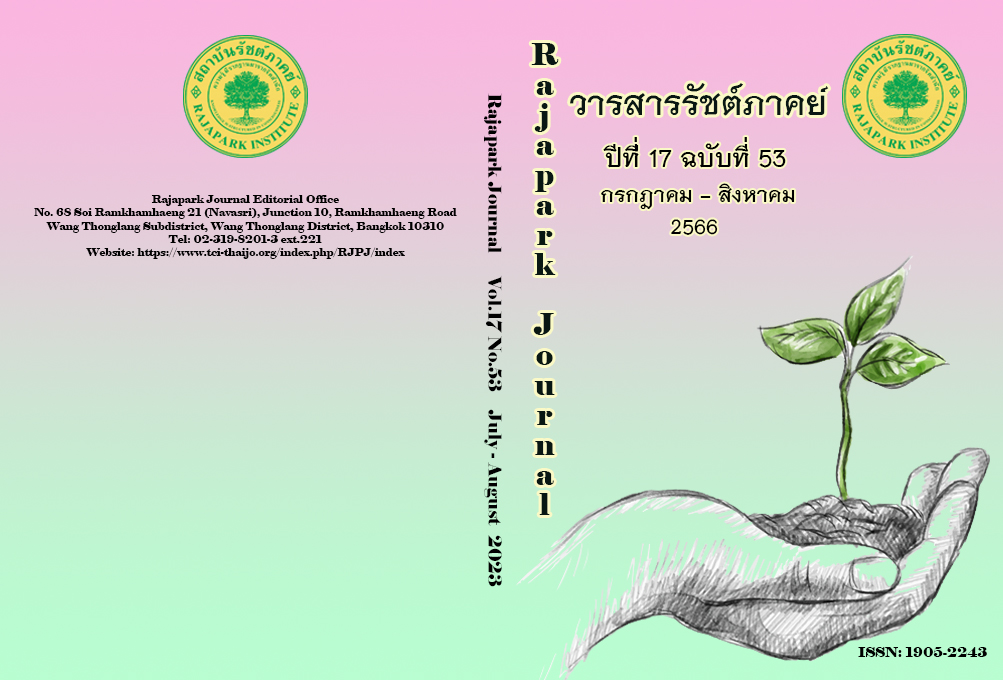นวัตกรรมองค์กรและการจัดการความรู้ในฐานะตัวแปรคั่นกลางที่เชื่อมโยงระหว่างภาวะผู้นำการเปลี่ยนแปลงสู่ประสิทธิภาพการทำงานของบุคลากรในองค์การบริหารส่วนจังหวัดในกลุ่มจังหวัดภาคใต้ฝั่งอันดามัน
Main Article Content
บทคัดย่อ
การวิจัยครั้งนี้มีวัตถุประสงค์เพื่อ 1) ศึกษาระดับปัจจัยภาวะผู้นำการเปลี่ยนแปลง นวัตกรรมองค์กร การจัดการความรู้ และประสิทธิภาพการทำงานของบุคลากรในองค์การบริหารส่วนจังหวัดในกลุ่มจังหวัดภาคใต้ฝั่งอันดามัน 2) ศึกษานวัตกรรมองค์กรและการจัดการความรู้ในฐานะตัวแปรคั่นกลางที่เชื่อมโยงระหว่างภาวะผู้นำการเปลี่ยนแปลง
สู่ประสิทธิภาพการทำงานของบุคลากรในองค์การบริหารส่วนจังหวัดในกลุ่มจังหวัดภาคใต้ฝั่งอันดามัน ใช้วิธีการวิจัยแบบผสม ได้แก่ (1) การวิจัยเชิงคุณภาพ กลุ่มตัวอย่าง คือ ผู้บริหารจากองค์การบริหารส่วนจังหวัด 6 จังหวัด ๆ ละ 1 ท่าน (2) การวิจัยเชิงปริมาณ กลุ่มตัวอย่าง ได้แก่ บุคลากรในองค์การบริหารส่วนจังหวัด จำนวน 500 ตัวอย่าง การกำหนดกลุ่มตัวอย่างแบบชั้นภูมิและสุ่มตัวอย่างแบบง่าย เครื่องมือที่ใช้ คือแบบสอบถาม สถิติที่ใช้ในการวิเคราะห์ ได้แก่ การแจกแจงค่าความถี่ ร้อยละ ค่าเฉลี่ย ส่วนเบี่ยงเบนมาตรฐานและการวิเคราะห์สมการโครงสร้างด้วยโปรแกรม PLS Graph 3.0 ผลการวิจัยพบว่า 1) บุคลากรมีระดับของคุณภาพระบบสารสนเทศ การยอมรับเทคโนโลยี การยอมรับนวัตกรรม และประสิทธิภาพการทำงาน มีค่าเฉลี่ยโดยรวมอยู่ในระดับมาก 4.05, 4.08, 3.96 และ 4.14 และส่วนเบี่ยงเบนมาตรฐานเท่ากับ .743, .600, .628 และ .529 และ 2) ภาวะผู้นำการเปลี่ยนแปลง นวัตกรรมองค์กร และการจัดการความรู้มีอิทธิพลทางตรงต่อประสิทธิภาพในการทำงาน มีค่าเท่ากับ 0.489, 0.077 และ 1.393 โดยที่ภาวะผู้นำการเปลี่ยนแปลงยังมีอิทธิพลทางอ้อมต่อประสิทธิภาพในการทำงาน มีค่าเท่ากับ 1.337
Article Details

This work is licensed under a Creative Commons Attribution-NonCommercial-NoDerivatives 4.0 International License.
ทัศนะและความคิดเห็นที่ปรากฏในวารสาร ถือเป็นความรับผิดชอบของผู้เขียนบทความนั้น และไม่ถือเป็นทัศนะและความรับผิดชอบของกองบรรณาธิการ
References
Adegbile, A., Sarpong, D., & Meissner, D. (2017). Strategic Foresight for Innovation Management: A Review and Research Agenda. International Journal of Innovation and Technology Management, 14(4). https://doi.org/10.1142/S0219877017500195
Al-Malki, M., & Juan, W. (2018). Leadership Styles and Job Performance: A Literature Review. Journal of International Business Research and Marketing, 3(3), 40-49. DOI: 10.18775/jibrm.1849-8558.2015.33.3004
Anderson, M. (2017). Transformational Leadership in Education: A Review of Existing Literature. International Social Science Review, 93(1), 1-13. https://www.jstor.org/stable/90012919
Andriani, S., Kesumawati, N., & Kristiawan, M. (2018). The Influence of the Transformational Leadership and Work Motivation on Teachers Performance. International Journal of Scientific & Technology Research, 7(7), 19-29. https://www.ijstr.org/final-print/july2018/The-Influence-Of-The-Transformational-Leadership-And-Work-Motivation-On-Teachers-Performance.pdf
Asbari, M., Santoso, P. B., & Prasetya, A. B. (2020). Elitical and Antidemocratic Transformational Leadership Critics: Is It Still Relevant? (A Literature Study). International Journal of Social, Policy and Law, 1(1), 12-16. https://www.academia.edu/79280335/Elitical_And_Antidemocratic_Transformational_Leadership_Critics_Is_It_Still_Relevant_A_Literature_Study_
Azar, G., & Ciabuschi, F. (2017). Organizational Innovation, Technological Innovation, and Export Performance: The Effects of Innovation Radicalness and Extensiveness. International Business Review, 26(2), 324-336. https://www.sciencedirect.com/science/article/abs/pii/S0969593116301147?via%3Dihub
Bass, B., & Avolio, B. (2000). Technical Report, Leader Form, Rater Form, and Scoring Key of MLQ From 5x-Short (2nd ed). Mind Garden.
Campbell, J. W. (2018). Efficiency, Incentives, and Transformational Leadership: Understanding Collaboration Preferences in The Public Sector. Public Performance & Management Review, 41(2), 277-299. https://www.tandfonline.com/doi/abs/10.1080/15309576.2017.1403332
Chen, J., Leung, W. S., & Evans, K. P. (2018). Female Board Representation, Corporate Innovation and Firm Performance. Journal of Empirical Finance, 48, 236-254. https://www.sciencedirect.com/science/article/abs/pii/S0927539818300525
Comrey, A. L., & Lee, H. B. (1992). Interpretation and Application of Factor Analytic Results. In Comrey, A. L. & Lee, H. B. (Eds.), A First Course in Factor Analysis. Lawrence Erlbaum Associates.
Hair, J. F., Risher, J. J., Sarstedt, M., & Ringle, C. M. (2019). When to Use and How to Report the Results of PLS-SEM. European Business Review, 31(1), 2-24. https://www.emerald.com/insight/content/doi/10.1108/EBR-11-2018-0203/full/html
Harb, B., & Sidani, D. (2019). Transformational Leadership for Organizational Change in the Lebanese Public Sector. Problems and Perspectives in Management, 17(2), 205–216. https://www.researchgate.net/publication/333238120_Transformational_leadership_for_organizational_change_in_the_Lebanese_public_sector
Jalagat, R. (2017). Determinants of Job Stress and Its Relationship on Employee Job Performance. American Journal of Management Science and Engineering, 2(1), 1-10. https://www.researchgate.net/publication/313887881_Determinants_of_Job_Stress_and_Its_Relationship_on_Employee_Job_Performance
Jonsen, K., & Jehn, K. A. (2009). Using Triangulation to Validate Themes in Qualitative Studies. Qualitative Research in Organizations and Management: An International Journal, 4(2), 123-150. https://www.emerald.com/insight/content/doi/10.1108/17465640910978391/full/html
Kongrit, K. (2020). Knowledge-Based Economy Development. to The Creative Economy. http://www.fpojournal.com/creative-economy.
Krabi Provincial Administrative Organization. (2023). Workforce Planning Plan 3 years (2021 – 2023). https://www.krabipao.go.th/files/com_networknews/2021-08_f7bf7e697287605.pdf
Likert, R. (1932). A Technique for the Measurement of Attitudes. Archives of Psychology, 140(22), 5-55. https://legacy.voteview.com/pdf/Likert_1932.pdf
Morley, M. (2020). Type of Transformational Leadership. https://smallbusiness.chron.com/types-transformational-leadership-79286.html
Na-Nan, K., Chaiprasit, K., & Pukkeeree, P. (2018). Factor Analysis-Validated Comprehensive Employee Job Performance Scale. International Journal of Quality & Reliability Management, 35(10), 1-20. https://www.emerald.com/insight/content/doi/10.1108/IJQRM-06-2017-0117/full/html
Panya, A. (2014), Factors Affecting Characteristics of Learning Organization in Ratchaphruek College, Panyapiwat Journal, 5(2), 180-190. https://so05.tci-thaijo.org/index.php/pimjournal/article/view/20176/17519
Pellegrini, M. M., Ciampi, F., Marzi, G., & Orlando, B. (2020). The Relationship Between Knowledge Management and Leadership: Mapping the Field and Providing Future Research Avenues. Journal of Knowledge Management, 24(6), 1445-1492. https://www.emerald.com/insight/content/doi/10.1108/JKM-01-2020-0034/full/html
Phangnga Provincial Administrative Organization. (2023). Workforce Planning Plan 3 years (2021 – 2023). https://www.phangngapao.go.th/files/com_news_power/2022-4_2b820f4721fc689.pdf
Phuket Provincial Administrative Organization. (2023). Workforce Planning Plan 3 years (2021 – 2023). https://phuketpao.go.th/files/com_document_power/2021-11_1f870a5eda41e83.pdf
Ranong Provincial Administrative Organization. (2023). Workforce Planning Plan 3 years (2021 – 2023). https://ranongpao.go.th/public/list/data/detail/id/5294/menu/1196/page/1/catid/4
Satun Provincial Administrative Organization. (2023). Workforce Planning Plan 3 years (2021 – 2023). https://satunpao.go.th
Rusland, S. L., Jaafar, N. I., & Sumintono, B. (2020). Evaluating Knowledge Creation Processes in The Royal Malaysian Navy (RMN) Fleet: Personnel Conceptualization, Participation and Differences. Cogent Business & Management, 7(1), 1785106. https://www.tandfonline.com/doi/full/10.1080/23311975.2020.1785106.
Shannak, R., Maqableh, M., & Tarhini, A. (2017). The Impact of Knowledge Management on Job Performance in Higher Education: The Case of the University of Jordan. Journal of Enterprise Information Management, 30(2), 244-262. https://www.emerald.com/insight/content/doi/10.1108/JEIM-09-2015-0087/full/html
Sucharitkul, J. (2019). Transformational Leadership among Administrators of The Local Government Administration in Thailand 4.0 Era: A Case Study of Phuket Local Government Administration. Journal of MCU Nakhondhat, 6(10), 4930-4943. https://so03.tci-thaijo.org/index.php/JMND/article/view/215639/162262
Takanashi, T. (2006). Entirety and Individuality of Chi. (Special Issues: The Knowledge Forum 2005--Japanese Chi: Edge of Evolution). 日本ナレッジ・マネジメント学会 編, (7), 85-98. https://cir.nii.ac.jp/crid/1520853833658781056
Trang Provincial Administrative Organization. (2023). Workforce Planning Plan 3 years (2021 – 2023). https://www.trangpao.go.th/files/com_news_hr/2022-06_a91a6c118b8723a.pdf
Yu, Y., Jia, T., & Chen, X. (2017). The ‘How’ and ‘Where’ of Plant MicroRNAs. New Phytologist, 216(4), 1002-1017. https://nph.onlinelibrary.wiley.com/doi/epdf/10.1111/nph.14834

